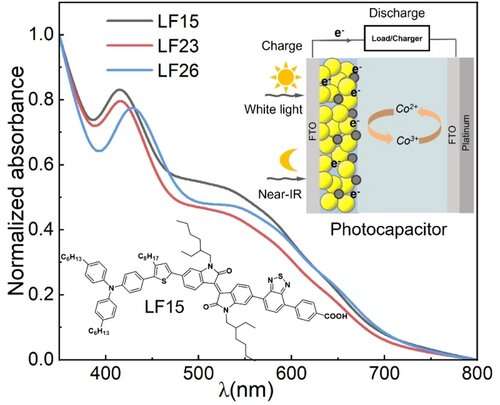This article has been reviewed according to Science X's editorial process and policies. Editors have highlighted the following attributes while ensuring the content's credibility:
fact-checked
peer-reviewed publication
trusted source
proofread
Scientists use single dye-sensitized solar cell as a photocapacitor

A photocapacitor integrating both energy harvest and storage functions into a single component can serve as a wireless charging source for mobile devices. However, current photocapacitors usually contain more electrodes or fabricated counter electrodes acting as additional capacitive components, resulting in increased fabrication costs.
In a study published in Chemistry—An Asian Journal, the group led by Prof. Gao Peng from Fujian Institute of Research on the Structure of Matter of the Chinese Academy of Sciences, and Prof. Hoi Nok Tsao from Nanyang Technological University, used a single dye-sensitized solar cell (DSSC) as a photocapacitor without introducing additional capacitive components. Depending on the absorption range of sensitizers integrated into the device, the charging of such single-component photocapacitors (SCPCs) can be triggered under day-or-room light and even near-infrared (IR) radiation.
The researchers synthesized three new dyes, all exhibiting panchromatic absorption from the visible to the near-IR region. They tested the dye-loading amount (Cm) on the surface of mesoporous TiO2 films. The results showed that LF15 has higher dye loading of 16.1 nmol cm-2 μm-1, due to the floppy feature of the C=C double bond in cyanoacetic acid. When anchored to the TiO2 surface, the dye molecules may be tilted, leading to a decrease in the Cm of LF23 and LF26.
After the photocapacitor is fully charged, the discharge behavior of various applied current densities indicated that the voltage supplied by the cell drops more slowly with lower applied currents. The researchers estimated the specific capacitance (CS) from the VOC decay under an applied external current of -700 nA after charging. Under white light, the CS of LF23 is 2.87 mF cm-2, slightly higher than those of the other two dyes.
In addition, the researchers found that for DSSC-based photocapacitors, external quantum efficiencies (EQE) and short-circuit current density (JSC) are not directly correlated, and the JSC value measured by EQE is related to the charging speed of the photocapacitor. Although LF15-based photocapacitors charge more slowly, especially at lower light intensities, during the fast JSC measurement at a specific EQE wavelength, the number of TiO2 electrons extracted at the short circuit is also limited, leading to the observed lower EQE for the LF15 cell.
Furthermore, the researchers tested the device's operational stabilities by stressing them through 50 cycles of charging and discharging with no significant losses in maximum VOC for white and near-IR light exposures.
This study provides possibilities for developing low-cost, easy-to-manufactured wireless charging devices.
More information: Feng Li et al, White Light to Near‐IR Chargeable Single Component Photocapacitor Based on Donor‐chromophore‐Acceptor Dyes, Chemistry—An Asian Journal (2023). DOI: 10.1002/asia.202300188



















